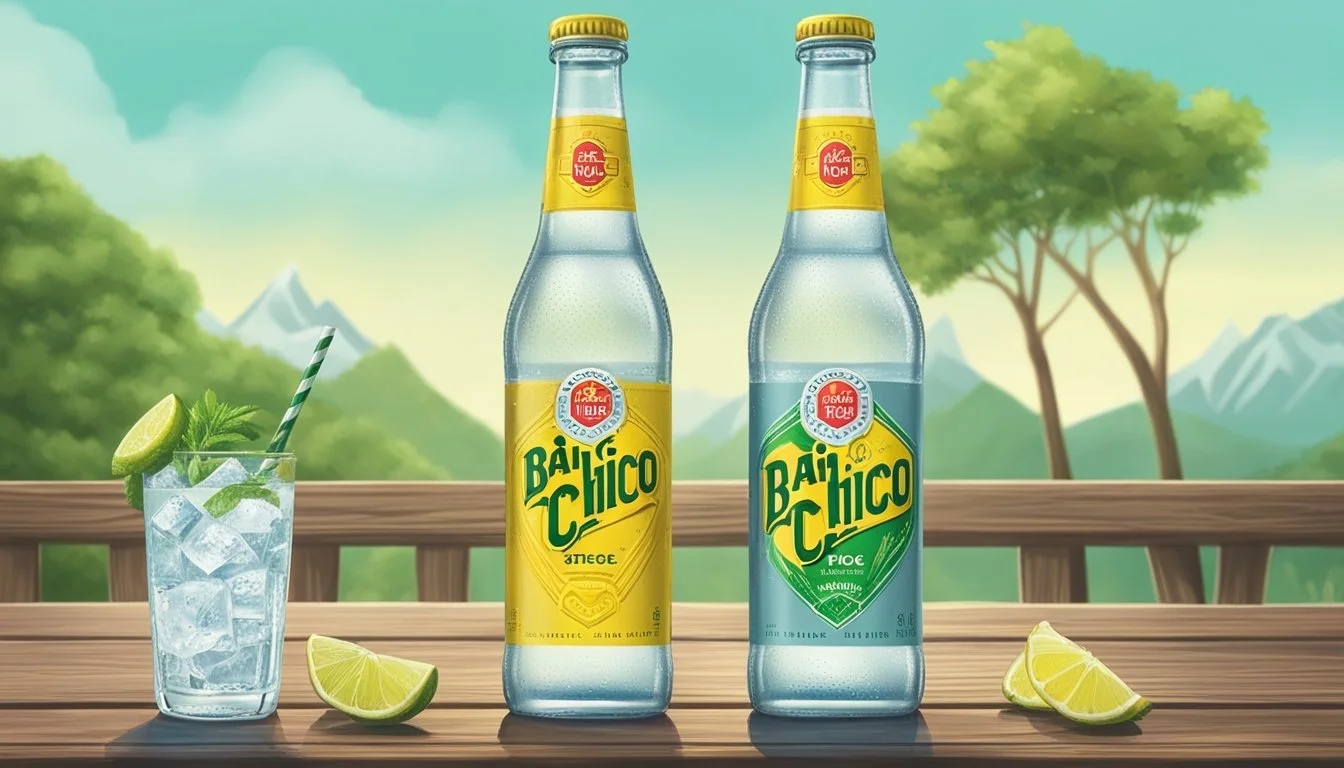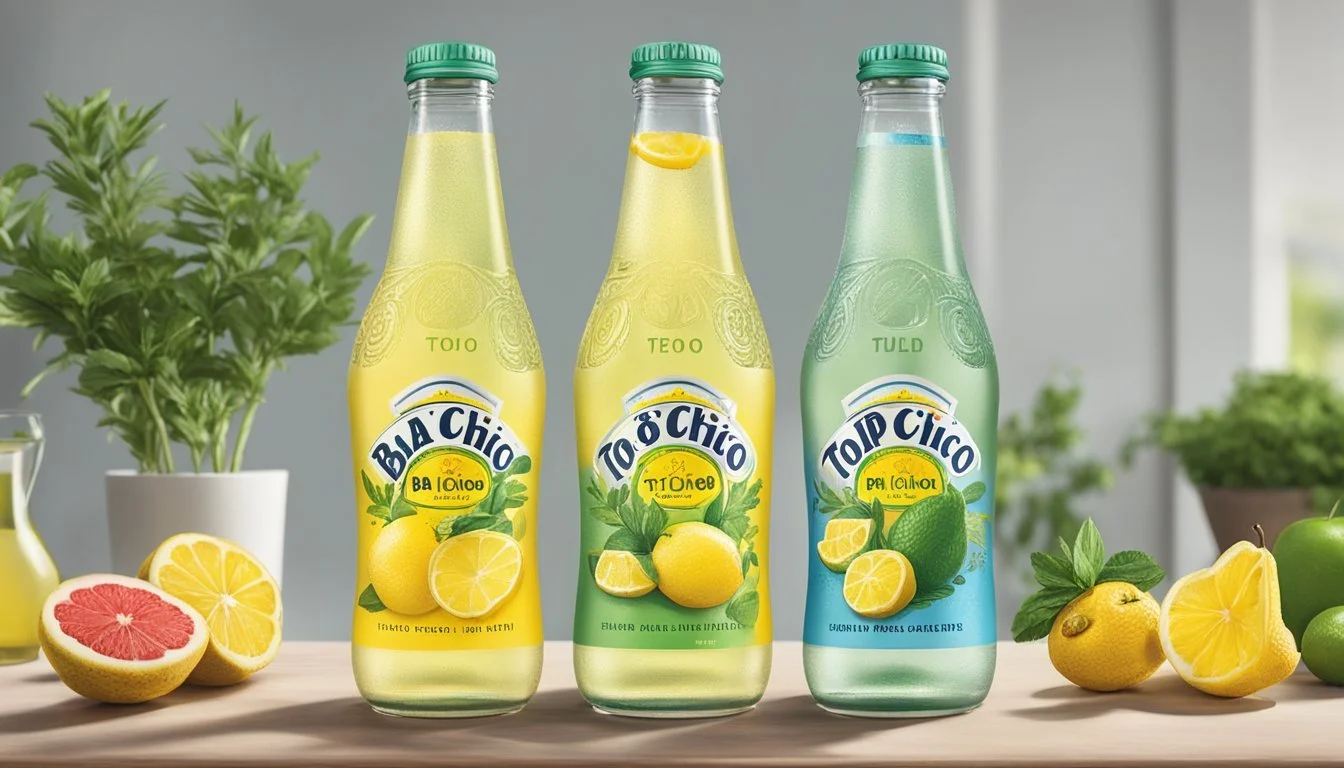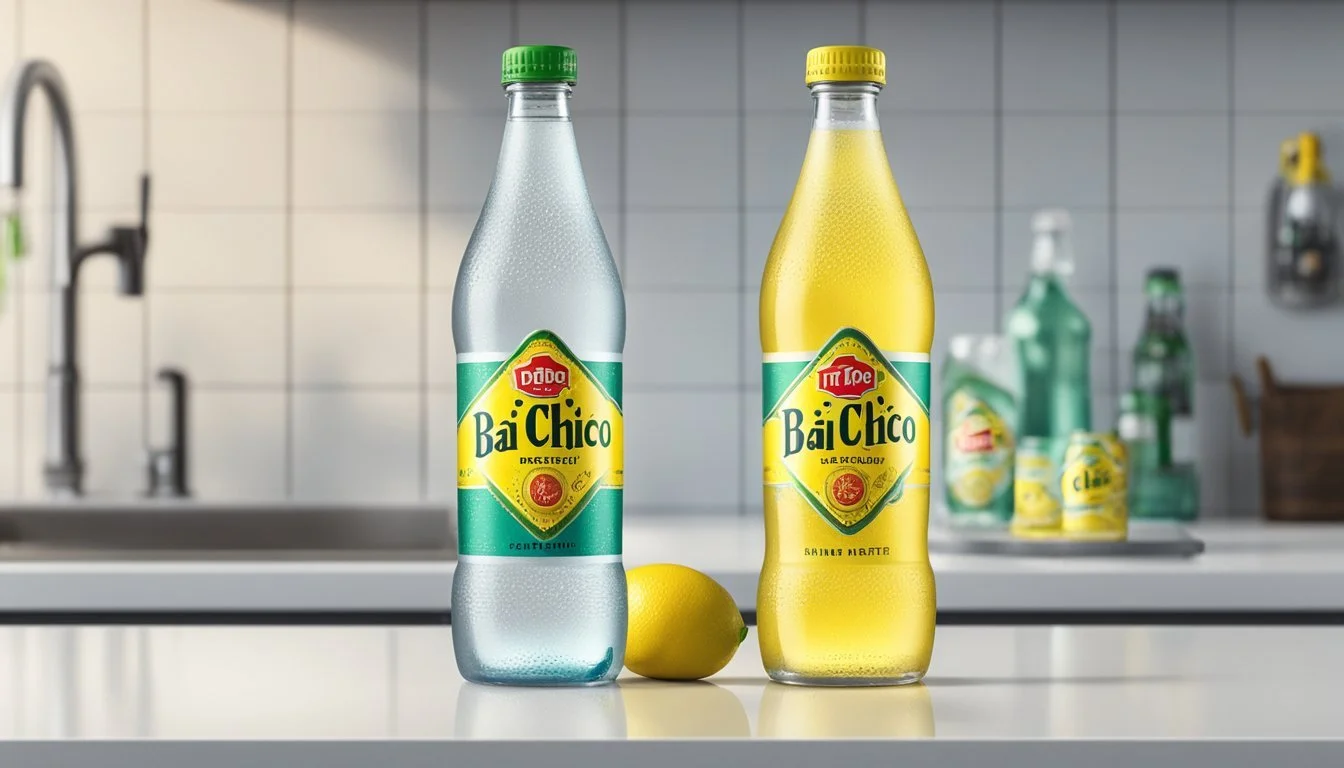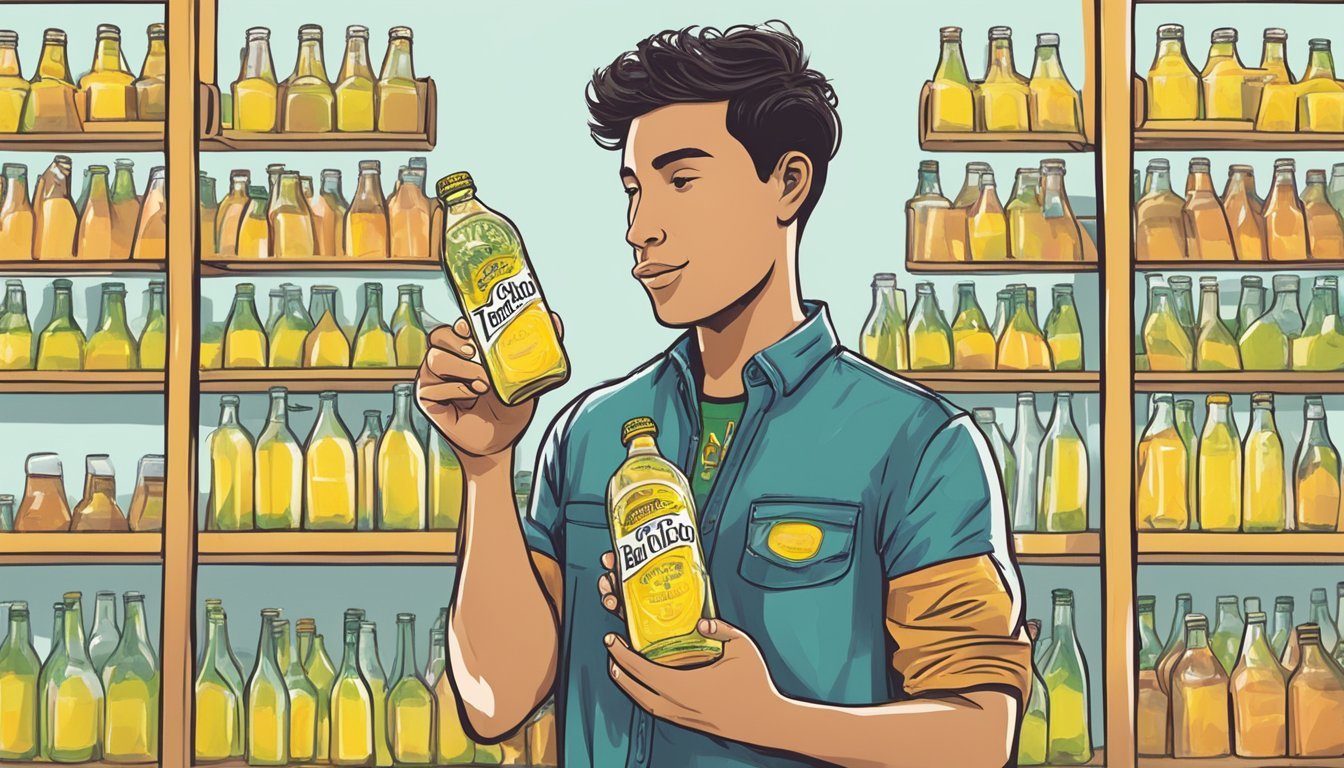Bai vs. Topo Chico
The Ultimate Bottled Water Showdown
When it comes to bottled water, consumers are faced with a myriad of choices, each boasting unique benefits and taste profiles. Among the contenders in the world of bottled beverages, Bai and Topo Chico have emerged as two popular options, though for different reasons. Bai brands itself as an antioxidant infusion, providing flavored water with added vitamins and minerals, while Topo Chico, a renowned sparkling mineral water, is sourced from springs in Monterrey, Mexico, offering a crisp carbonation beloved by many.
The debate over Bai versus Topo Chico centers on several factors, such as taste, health benefits, and carbonation preferences. Bai presents an array of exotic fruit flavors and is sweetened with erythritol and stevia, catering to those who prefer a sweet, yet low-calorie drink. Topo Chico, on the other hand, is often celebrated for its sharp effervescence and mineral content, which aficionados claim lend it a refreshing edge over other sparkling waters.
When making a choice between the two, consumers weigh their options based on individual taste preferences and desired beverage benefits. They might analyze the sugar content, the type and intensity of flavors, or the potential health impacts of added vitamins and minerals versus naturally occurring elements in mineral water. Each brand has carved out its niche, speaking to differing demands in the bottled water market.
Overview of Bai and Topo Chico
Bai offers a variety of antioxidant-infused beverages that are known for their flavorful taste without the accompaniment of artificial sweeteners. These drinks are typically characterized by their fruit-forward profiles and include options that are both still and sparkling.
Topo Chico, on the other hand, is a sparkling mineral water beloved for its crisp carbonation and refreshing taste. Originating from Monterrey, Mexico, this water has been sourced from the Cerro del Topo Chico spring since 1895. Topo Chico is naturally carbonated at the source but undergoes additional carbonation during bottling to replenish any lost bubbles.
Aspect Bai Topo Chico Type Antioxidant beverage, Sparkling water Mineral water, Sparkling water Origin United States Monterrey, Mexico Key Features Antioxidant-infused, Variety of flavors Natural carbonation, Mineral enrichment Sweetener No artificial sweeteners No sweeteners, Unsweetened Carbonation Available in still and sparkling versions High carbonation
In terms of water brands, Bai positions itself as a healthy, antioxidant-rich drink option, whereas Topo Chico is appreciated for its authenticity and tradition in the mineral water market. When assessing taste and flavor, Bai is known for creative combinations and sweetness, whereas Topo Chico maintains a neutral water taste accented by its mineral content and effervescence.
Historical Background
In this section, the historical origins of both Bai and Topo Chico are investigated, revealing their unique journeys from inception to becoming popular bottled water brands in the marketplace.
Origins of Bai
Bai beverages were introduced in 2009 by entrepreneur Ben Weiss. Weiss sought to create a drink that was both flavorful and health-conscious. Bai, which means "pure" in Mandarin, was thus created as a line of antioxidant-infused beverages. The brand became well-known for using the coffee fruit for its antioxidant properties, and sweetening its drinks with natural sweeteners.
History of Topo Chico Mineral Water
Topo Chico traces its roots back to Monterrey, Mexico, where the water has been sourced and bottled at the Cerro del Topo Chico spring since 1895. According to legend, an Aztec princess was cured of her ailments by bathing in and drinking the water from the spring. Today, the brand is owned by Coca-Cola and has gained a significant following in Texas and beyond, noted for its strong carbonation and mineral content.
Product Profiles
This section examines the nutritional properties and mineral contents of Bai beverages and Topo Chico mineral water, providing a comprehensive overview of what each offers.
Bai Nutritional Information
Bai beverages are known for their antioxidant infusion and use of natural sweeteners. Here's a snapshot of what they contain:
Calories: Low-calorie count, typically under 10 calories per serving.
Antioxidants: Contains antioxidants sourced from coffee fruit and white tea extract.
Sweeteners: Utilizes erythritol and stevia, which are natural, low-calorie sweeteners.
Electrolytes: Includes a small amount of potassium electrolyte for hydration.
Topo Chico Mineral Content
Topo Chico is celebrated for its high mineral content and crisp carbonation. The specifics of its mineral composition are as follows:
Calcium: It provides calcium, essential for bone health.
Magnesium: Contains magnesium, which supports a variety of bodily functions.
Potassium: Offers potassium, crucial for muscle function and overall cellular health.
Sodium: A moderate amount of sodium aids in hydration by maintaining the body's fluid balance.
Electrolytes: These minerals, present in the water, also act as electrolytes to help replenish the body during hydration.
Taste and Flavor Comparison
When contrasting Bai and Topo Chico bottled waters, one must consider the variety of flavors available and the level of carbonation, as these aspects greatly influence overall taste.
Flavor Variety
Bai: Bai offers a range of infused water flavors, among which are Costa Rica Clementine, Brasilia Blueberry, and Malawi Mango. These flavors are derived from a combination of fruit extracts and the subtle sweetness of erythritol and stevia leaf extract, without artificial sweeteners.
Topo Chico: In terms of Topo Chico, the brand offers flavors such as Twist of Lime and Twist of Grapefruit. These are infused with natural flavorings to provide a refreshing twist on their traditional mineral water, rather than a pronounced flavor found in many soft drinks or flavored waters.
Carbonation Levels
Bai: Bai beverages are not carbonated. They provide a smooth, still water experience with a hint of flavor, catering to those who prefer non-fizzy refreshment.
Topo Chico: On the other hand, Topo Chico is recognized for its high level of carbonation which gives it a noticeably crisp and refreshing characteristic. Each flavored variety, such as their Lime or Grapefruit, is accompanied by this fizzy sensation, which can enhance the perceived intensity of the flavor.
Packaging and Environment
While examining the packaging choices of Bai and Topo Chico, it's essential to explore the materials used and their respective environmental impacts in order to make an informed decision about which bottled water is better for the planet.
Glass Bottle Versus Other Materials
Topo Chico is renowned for its signature glass bottles, whereas Bai primarily uses plastic. Glass provides an excellent barrier against oxygen and contaminants, ensuring the water's purity and taste. While glass is heavier and may incur more shipping weight, it is endlessly recyclable, reducing waste.
In contrast, although plastic bottles can be recycled, they usually have a finite number of cycles before they no longer can be reused. Furthermore, plastic production involves petrochemicals and can release harmful substances if not properly treated.
Environmental Impact
Topo Chico's decision to use glass bottles reflects a commitment to sustainability, as glass manufacturing typically results in fewer chemical emissions compared to plastic. However, the transportation of heavier glass bottles does result in a larger carbon footprint.
Bai, by packaging in plastic, could potentially have a lesser immediate environmental impact in terms of transportation. However, the longevity of plastic in the environment and its tendency to add to the growing problem of plastic waste cannot be overlooked.
Both brands have the responsibility to ensure efficient recycling programs and to educate consumers on the best practices to minimize environmental harm. The ultimate question for consumers may not just be which brand tastes better, but which aligns more closely with their own environmental values.
Health and Safety Considerations
When assessing bottled water options like Bai and Topo Chico, consumers should prioritize health and safety. This includes understanding hydration benefits as well as potential risks from contaminants.
Hydration and Electrolyte Balance
Both Bai and Topo Chico contribute to hydration, which is essential for bodily functions. Electrolytes, minerals such as sodium and potassium that are crucial for nerve and muscle function, are present in Topo Chico due to its mineral composition. Bai beverages, typically infused with antioxidants and natural flavors, also provide hydration, though their electrolyte content may be naturally less prominent than in mineral waters.
Contaminant Levels and Regulations
PFAS chemicals (per- and polyfluoroalkyl substances) are a group of man-made chemicals that have been linked to adverse health effects, including cancer. Recent tests have shown a reduction of PFAS levels in Topo Chico. The brand has made efforts to ensure that its mineral water tested below the PFAS levels set by Environmental Protection Agency (EPA) guidelines for drinking water.
Brand PFAS Levels (PPT) Topo Chico Reduced by >50% Bai Not specified
The EPA regulates contaminants in bottled water, setting legal limits on the amounts of certain contaminants. Clean water is vital for health, and both Bai and Topo Chico must comply with these regulations to ensure safety for consumption. It is essential for consumers to be aware of the contaminant levels in their chosen bottled water to make an informed decision.
Consumer Experience
The consumer experience for bottled water brands like Bai and Topo Chico includes perceptions of brand reputation and the enthusiasm of their customer bases. These elements shape the buying behaviors and loyalty of consumers.
Bai's Brand Reputation
Bai positions itself as an antioxidant infusion brand, offering beverages that are not only hydrating but also provide a nutritional boost. The company emphasizes the inclusion of antioxidants in its products, which some consumers may associate with health benefits. Doctors and nutrition experts often weigh in on such claims, urging buyers to evaluate the supplemental values of beverages alongside regular dietary intake. While Bai doesn't claim any healing powers, the brand's marketing suggests a health-conscious choice for those looking to stay hydrated and enjoy a flavorful experience.
Antioxidants infused: Claimed to contribute to health
Flavor variety: A selling point for consumers looking for alternatives to plain water
Community and Cult Following of Topo Chico
Topo Chico, on the other hand, enjoys a robust cult following, particularly for its crisp and strong carbonation which plausibly contributes to its esteemed position among seltzer waters. Consumer reports often highlight Topo Chico's loyal customer base that appreciates its unique taste and effervescence. This mineral water has a long history that lends to its credibility and allure. Unlike Bai, Topo Chico does not make health claims, but its fans appreciate the product for its purity and the invigorating experience it provides.
Strong carbonation: A key feature appreciated by the seltzer community
Long-standing history: Over 120 years, enhancing its brand image
Market Presence and Availability
In the competitive landscape of bottled water, Bai and Topo Chico have carved out distinct market presences and boast varied availability across sales channels and global distribution.
Sales Channels
Bai has established its market presence through a diverse range of sales channels, encompassing large retailers, grocery chains, and e-commerce platforms with Amazon being a notable online venue. It's not uncommon to find Bai's antioxidant-infused waters available in single bottles and multi-packs, appealing to both individual consumption and bulk purchase.
In contrast, Topo Chico, a sparkling mineral water brand with over 120 years of history and a recent surge in U.S. sales, has seen its distribution further expand after being acquired by Coca-Cola. The acquisition has increased its visibility and availability beyond its traditional strongholds in northern Mexico and select U.S. states. Now, Topo Chico can be found in major supermarkets, convenience stores, and is readily accessible on online platforms, including Amazon.
Global Distribution
While Bai waters, known for their flavor-infused profiles, are readily available across the United States, their international presence is less pronounced compared to Topo Chico. However, they continue to grow their footprint in the bottled water market by leveraging robust local and national distribution networks and marketing strategies to reach broad demographics.
Topo Chico has leveraged Coca-Cola's extensive global distribution system to increase its availability both within the United States and internationally. The mineral water brand's recognition has been boosted in various markets, building a strong reputation as a premium sparkling water choice for consumers around the world.
Unique Uses and Mixology
When selecting a bottled water for mixology, it's essential to understand the distinct roles that Bai and Topo Chico play in the world of cocktails and mixers. Bai brings a variety of infused flavors to beverages, while Topo Chico is known for its high carbonation and mineral content, which can enhance the flavors of spirits.
Topo Chico in Cocktails
Topo Chico's high carbonation makes it a favorite for cocktails, particularly in creating a popular Mexican drink known as Ranch Water. This refreshing cocktail primarily includes Topo Chico, blanco tequila, and fresh lime juice. Topo Chico adds a burst of bubbles that complements the earthy notes of the tequila and the acidity of the lime, resulting in a well-balanced drink. Here's a typical recipe for Ranch Water:
Ingredients for Ranch Water:
2 oz blanco tequila
1/2 oz lime juice (about half a lime)
Topo Chico (to top up)
Instructions:
Fill a highball glass with ice.
Pour in the blanco tequila.
Squeeze in the fresh lime juice.
Top up with Topo Chico.
Stir gently and garnish with a lime wheel.
Topo Chico's effervescence is also valuable in a variety of other cocktails, acting as both a diluent and a source of carbonation. Its neutral flavor profile ensures it blends seamlessly with various ingredients without overpowering other flavors.
Bai as a Mixer
Bai beverages, with their bold fruit flavors and antioxidant infusions, serve as an innovative mixer for creative cocktails and hard seltzers. They offer a low-calorie alternative, imparting a subtle sweetness and fruitiness to drinks without adding refined sugars. Bai can be used to craft cocktails or to give an exotic twist to a simple hard seltzer. An example is a Bai-based cocktail mixer:
Simple Bai Cocktail Mixer Recipe:
1 bottle of Bai flavored water (flavor of choice)
2 oz vodka or white rum
Ice
Instructions:
Fill a glass with ice.
Pour in the vodka or rum.
Top with Bai.
Bai mixers can be customized with additional ingredients such as mint, basil, or even a splash of citrus juice to elevate the cocktail experience. Their versatility and health-conscious profile make them suitable for an audience seeking indulgence without excess calories.
Comparative Analysis of Water Quality
In assessing the water quality of Bai and Topo Chico bottled waters, one must examine both the purification and filtration processes as well as the mineral composition and its associated benefits. Each brand employs distinct methods to ensure safety and quality, and they each boast unique mineral profiles that contribute to their overall appeal.
Filtration and Purification Processes
Bai beverages emphasize their use of reverse osmosis, a sophisticated filtration process that removes impurities and contaminants to deliver purity in their enhanced waters. Topo Chico, on the other hand, being a mineral water, undergoes a natural filtration process as it percolates through the earth and is drawn from spring sources, which typically imbues it with various minerals. While Bai focuses on a technologically driven purification process, Topo Chico relies on the natural purification properties of its source, highlighting a key distinction in their approaches to water quality. Both methods aim to meet and exceed drinking water quality standards.
Mineral Composition and Benefits
Topo Chico is well-known for its rich mineral composition, including elements like calcium, magnesium, and sodium, which are inherent to its source spring in Monterrey, Mexico. Mineral water such as Topo Chico can offer health benefits like electrolyte replenishment. The mineral content is a result of the water's journey through the mountainous terrain that naturally enriches the water.
Bai, while not sourced as mineral water, boosts its quality by adding a variety of antioxidants and electrolytes post-filtration to enhance their water. This process is designed to contribute to health benefits such as combating oxidative stress.
By dissecting the water quality of both Bai and Topo Chico through their filtration, purification, and mineral composition, consumers can better understand the nature of what they are drinking and the potential benefits they may receive.
Regulatory and Industry Standards
In the bottled water industry, regulatory compliances and quality assurance practices are critical for consumer safety and brand reputation. Companies like Bai and Topo Chico are required to meet certain standards and often undergo several regulations and quality checks to ensure their products are safe for consumption.
Documentation and Certifications
Bai and Topo Chico must adhere to the Food and Drug Administration (FDA) regulations, as it is the governing body responsible for ensuring the safety and labeling of bottled water in the United States. Both brands have to comply with the FDA's Good Manufacturing Practices, which include proper sourcing, processing, and bottling. Certifications, such as those from the International Bottled Water Association (IBWA), signal that a company meets or exceeds industry standards.
Topo Chico: Previously showed high levels of PFAS but has reduced them, acting according to regulatory pressures and consumer safety expectations.
Bai: No specific incidence of exceeding PFAS levels publicly noted; however, it must also maintain permissible levels as per FDA and IBWA guidelines to avoid any class-action lawsuit.
In cases where limits are exceeded, there may be recalls, a ban on sales, or class-action lawsuits filed to protect consumer interests and hold companies accountable.
Quality Assurance Practices
Quality assurance in bottled water not only involves meeting regulatory limits on contaminants but also involves consistent internal testing and monitoring.
Topo Chico: Following consumer reports of PFAS levels, which can lead to a class-action lawsuit, their commitment to quality assurance includes reducing PFAS levels. Their practices are now under closer scrutiny from both regulators and consumers.
Bai: Quality assurance practices must prevent contaminants in its products and may involve routine testing to avoid any regulatory issues, such as a ban or limit being imposed on their product.
Both brands are expected to document their quality testing results and provide transparency to consumers, ensuring that they consistently produce safe, high-quality products.
Consumer Advocacy and Reports
In choosing between Bai and Topo Chico bottled waters, consumers often look to reviews and third-party certifications to guide their decisions. This information can provide assurance regarding quality, safety, and environmental impact.
Reviews and Testimonials
Consumers frequently consult reviews and testimonials to gauge the quality and taste preferences of bottled water brands. Consumer Reports has tested various water brands, including Topo Chico, for levels of PFAS chemicals—a group of substances linked to health issues. According to their findings, Coca-Cola has significantly reduced PFAS levels in Topo Chico. Reviews and testimonials can also reflect customer satisfaction and preferences, though they are subjective and can vary widely.
Topo Chico: Improved PFAS levels, popular for its sparkling mineral content.
Bai: Offers flavored water options and is known for adding antioxidants to its beverages.
Brand Customer Sentiment Topo Chico Positive reviews for mineral content Bai Loyal following for flavor and ingredients
Third-Party Certifications
Third-party certifications provide an added level of trust and ensure that bottled water brands meet specific safety and quality standards. For instance, certifications can indicate whether the water comes from a natural spring or if it has undergone purification processes like reverse osmosis. While Bai and Topo Chico do not have widespread certifications mentioned in the search results, other notable brands hold various accreditations:
Evian: Sourced from springs in the French Alps, known for its natural filtration process.
Fiji: Draws water from an artesian aquifer in the Fiji Islands, with a unique mineral profile.
Nestlé Pure Life: Utilizes a multi-step purification process and enhances the water with a blend of minerals.
Brand Certifications Evian Natural spring, internationally recognized Fiji Artesian source, distinct mineral composition Nestlé Pure Life Purified water, enhanced with minerals
The endorsements from third parties are essential for consumer confidence, especially when choosing between lesser-known brands like Bai and more established ones such as Topo Chico.
Trends and Innovations
In the bottled water sector, recent years have witnessed notable shifts toward new market entrants and the expansion of product lines, including the surge of hard seltzer varieties.
Emerging Water Brands
Emerging water brands have been distinguishing themselves from established players through innovation and targeted marketing. Bai has made an entry with an offering of antioxidant-infused water. Essentia, another key player, stands out with its ionized alkaline water, boasting a pH of 9.5 for a clean and crisp taste-claim. LaCroix, while not a newcomer, has seen its popularity surge, leveraging its flavored sparkling water without artificial sweeteners, which aligns with the trend toward healthier beverage choices.
Growth of the Hard Seltzer Market
The hard seltzer market is experiencing rapid growth, with water brands venturing into this segment to capture a share of the rising demand for alcoholic seltzer products. LaCroix capitalized on its existing customer base by introducing its own hard seltzer line, LaCroix Hi-Biscus. Meanwhile, companies like Spindrift entered the space with their own iterations, focused on real-fruit-infused sparkling water with alcohol. The market has expanded to include diverse varieties and brands, such as VICE hard seltzer, reflecting consumers' increasing preference for low-calorie, low-sugar alcoholic beverage options.












